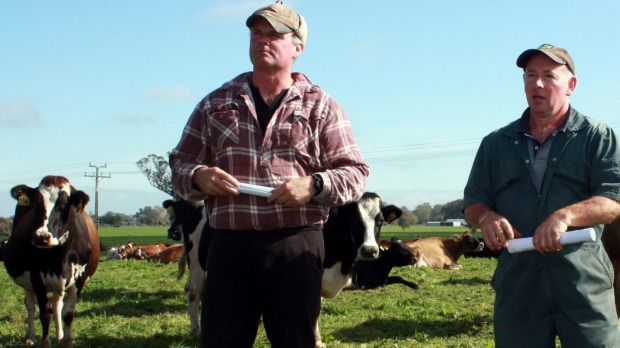
Source: Stuff
It will take at least two years for Andrew McGiven’s dairy farm business to recover from the current slump in dairy prices.
The sharp fall in prices had eroded any profit made from last year’s record payout, the Waikato farmer told about 30 farmers at a field day on his farm on Wednesday.
McGiven’s projected income had halved from $1,809,786 ($8/kg MS) in 2013-14 to $967,000 (4.20/kg MS) for 2015-16. The drop was due to the milk price fall, his decision to employ contract milker Graham Wallace and the time lag that occurred for supplementary feed costs to fall in line with the payout drop.
McGiven’s 135ha business is a farm used as part of DairyNZ’s tactics for tight times campaign to provide advice on coping with the low payout.
He would hit his $300,000 overdraft limit on June 1. It had been on a downward spiral since January-February of this season.
“It’s been a sudden and sharp drop.”
He has also shifted to a winter milking system, which compounded the debt situation.
Adding to the pressure was the latest GlobalDairyTrade result, which saw international dairy prices fall 2.2 per cent. The auction is the final sale before Fonterra updates its forecast for the 2014-15 season and announces its opening forecast for the 2015-16 season on May 27.
Fonterra will also reveal its advanced rate. Once that is known, McGiven said he would then add those rates into the budget and sit down with his bank manager to determine what their requirements would be.
He planned to take a large part of his overdraft and put it into a term debt. He also ceased principle debt payments three months ago and is only looking to pay off interest.
“Essentially it’s going to set us back two years in our refinancing plan and any profit we made last year is probably going to be eaten up this year and it’s going to be at least a two-year turnaround.
“The banks have indicated they are happy enough with the plan going forward and are going to back us, which is good to hear. We’ll just keep plugging forward and hope for those GDT prices to lift. That’s what’s going to make or break us in the end.”
DairyNZ North Waikato regional leader Phil Irvine told farmers to go through each itemised cost in the budget to work out if anything can be reduced.
He also urged farmers not to forget to review their drawings, or personal expenses.
“Put aside $1000 a week to live on and then decide what to do after that.”
Most of the farmers attending the field day said they would be in a negative or a break even cash deficit for this season. One was still hopeful the forecast would pick up this season.
Farmers had to go “back to basics” and look to grow as much grass as possible to feed their cows because it was the cheapest feed source. If the El Nino weather pattern was correct, farmers had to be prepared and either de-stock or switch to once a day milking, another said.
Others also predicted it would be a two year turnaround for their farms to recover, provided the milk payout lifted.
Irvine said the next few months over spring would be tough because of the fall in retrospective payments. These are payments from milk that is produced this season but is paid to farmers over the winter and early spring.
A Waikato farm producing 100,000kg milk solids would only receive about 18-19c per kilogram of milk solids in these payments from Fonterra.
Last season those payments came in at about $1.90/kg MS, he said.
“That’s why the bank balance is going to be pretty lean this winter and spring,” he said.
He said the average Waikato farmer milking 330 cows would have a cash deficit of $46,834. For a 50:50 sharemilker milking 337 cows, that deficit came in at $44,845.



